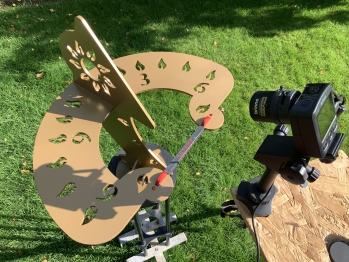There are many interpretations of how well a sundial reads the time. It is often thought the smallest increment of time on a sundial will be around two minutes. This is because the large diameter of the sun gives a fuzzy edge to the time shadow. Our study looked at the shadow using a time lapse camera. The results are interesting.
The Dihelion sundial was ideal for the study because of the clarity of its shadow cast by the gnomon onto the dial. It was positioned for viewing in front of a Brinno® time lapse camera. This was set to run at 1 frame per minute. The camera was allowed to film for seven hours on a sunny day.
‘Time Lapse on a Sundial’ is a video summary of the results. The video playback speed is 1 frame per second, 60 times quicker than the camera, so 1 minute on video is 1 hour on the sundial. The time lapse steps show very clearly, at 1 minute intervals on the sundial. This is less than the two minute increment of time thought to be limited by fuzziness on the shadow of a gnomon. Further studies looking at smaller time increments will be considered.

